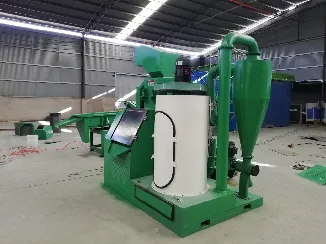

Ное . 27, 2024 10:16 Back to list
The Role of Plastic and Metal Shredders in Recycling and Sustainability
In our modern world, the accumulation of plastic and metal waste has become a pressing environmental issue. As industries and consumers continue to produce vast amounts of waste, the need for effective recycling solutions grows ever more critical. Among the various technological advancements aimed at addressing this challenge, plastic and metal shredders stand out as vital tools in the recycling process. These machines not only aid in the efficient processing of waste materials but also play a significant role in promoting sustainability and reducing environmental impact.
Plastic shredders are specialized machines designed to break down large volumes of plastic waste into manageable pieces. The process starts with collecting plastic products, ranging from bottles and containers to industrial scrap. Once gathered, these plastics are fed into the shredder, which uses sharp blades to chop them into smaller fragments. This size reduction ensures that the plastic can be easily processed in subsequent recycling operations. By transforming bulky waste into small particles, shredders facilitate easier handling, transportation, and processing, ultimately streamlining the recycling workflow.
Similarly, metal shredders function with the same core purpose but focus on different materials. They are engineered to shred various types of metals, including aluminum, steel, and copper. The shredding process for metals often involves more robust machinery that can withstand the toughness of metal. These machines not only reduce metal waste into smaller pieces but also help in liberating metals from non-metal components (like plastics and rubber). This is particularly crucial in the recycling industry, where material recovery rates are a key indicator of efficiency and sustainability.
The environmental benefits of using plastic and metal shredders are manifold. Firstly, shredders significantly reduce the volume of waste that needs to be transported to landfills. By breaking down materials, shredders help maximize space in recycling facilities and minimize the environmental impact associated with transporting large, bulky items. Furthermore, shredded materials are more convenient for sorting and processing, which leads to higher recycling rates and greater overall efficiency in the recycling industry.

Moreover, the shredding process contributes to the production of high-quality raw materials that can be reintroduced into the manufacturing cycle. For instance, shredded plastics can be melted down and molded into new products, while shredded metals can be melted and recast into new metal items. This not only conserves resources but also reduces the energy consumption associated with producing new materials. In the case of metals, recycling often requires significantly less energy compared to extracting and processing virgin ores.
Additionally, the use of shredders underscores the importance of the circular economy, an economic model that prioritizes sustainability by reusing resources rather than disposing of them. By implementing shredding technologies, businesses and communities can contribute to a more sustainable future, where materials are continuously cycled through the economy instead of being discarded as waste. Such practices not only reduce environmental pollution but also create economic opportunities in the recycling sector, fostering job creation and innovation.
Despite their many advantages, the operation of plastic and metal shredders does come with responsibilities. Proper maintenance and management are essential to ensure safety and efficiency. Shredders require regular checks to operate at optimal levels, and users must be trained to handle these machines to prevent accidents and maximize productivity. Furthermore, the environmental impact of shredding operations must be monitored, particularly with regard to noise and emissions.
In conclusion, plastic and metal shredders have emerged as indispensable tools in the quest for effective recycling and sustainability. By breaking down waste materials into smaller, manageable sizes, they enhance the efficiency of the recycling process while promoting the recovery of valuable resources. As we continue to confront the challenges posed by waste accumulation, investing in shredding technologies represents a significant step forward in our efforts to create a more sustainable and environmentally-friendly future. The continued development and implementation of these machines will play a crucial role in driving forward the circular economy and ensuring a cleaner planet for generations to come.
Latest news
Troubleshooting Common Eddy Separator Problems
NewsJul.04,2025
The Role of Metal Recycling Plants in Circular Economy
NewsJul.04,2025
The Impact of Recycling Line Pickers on Waste Management Costs
NewsJul.04,2025
Safety Features Every Metal Shredder Should Have
NewsJul.04,2025
How Industrial Shredders Improve Waste Management Systems
NewsJul.04,2025
How Cable Granulators Contribute to Sustainable Recycling
NewsJul.04,2025